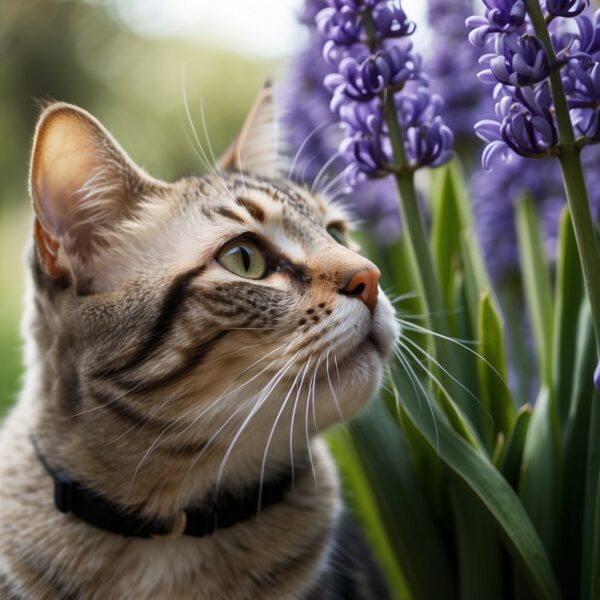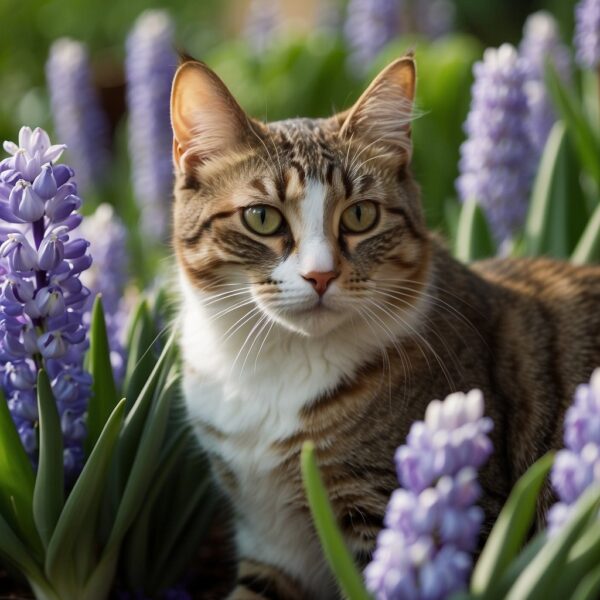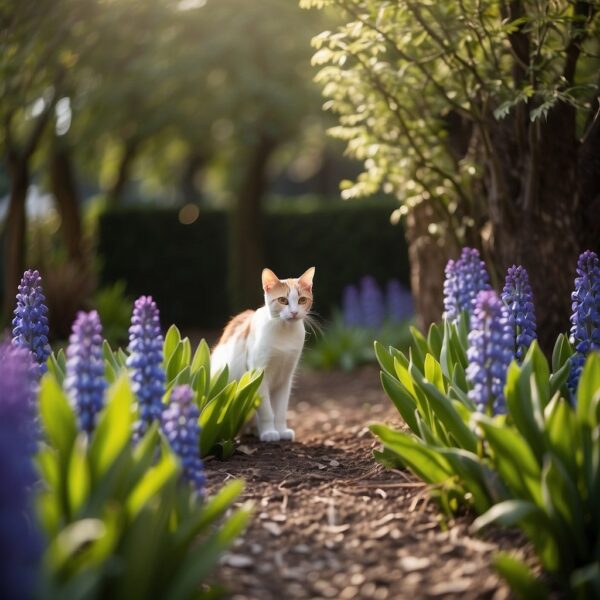
Hyacinths Are Poisonous to Cats
Hyacinths, with their vibrant blooms and fragrant scent, are popular flowers in gardens and homes. However, for cat parents, it is important to understand the risks these plants may pose to their feline companions. Hyacinths are poisonous to cats. Hyacinths contain compounds that are toxic to cats, such as oxalic acid and alkaloids like lycorine, which can be harmful if ingested.
Cats may exhibit symptoms of hyacinth poisoning such as vomiting, diarrhea, and drooling. More severe reactions can include depression, rapid breathing, and changes in heart rate. It’s particularly the bulbs of the hyacinth that hold the highest concentration of these toxins, making them especially dangerous if chewed or ingested by cats.
Key Takeaways
- Hyacinths contain toxic substances that can affect cats if ingested.
- The most dangerous part of the plant is the bulb, which has a higher concentration of toxins.
- Symptoms of poisoning in cats can range from gastrointestinal distress to more serious conditions like rapid breathing and heart rate changes.
What Are Hyacinths?
Hyacinths are highly fragrant, perennial plants known for their vibrant flowers that bloom in early spring. Revered for their beauty and scent, they are commonly used as ornamental plants.
Origin and Description
The hyacinth, part of the genus Hyacinthus, belongs to the family Asparagaceae. These bulbous flowers originate from the eastern Mediterranean region and have been cultivated since ancient times. A typical hyacinth displays a single dense spike, or cluster, of aromatic flowers. The flowers grow from thick, fleshy leaves that frame the flower cluster.
Hyacinths are notable for their rich variety of colors, ranging from white to blue, red, and purple. The stout stems support the weight of the flower clusters, and the waxy, bell-shaped flowers have a distinct look. During early spring, the blooms emerge to make hyacinths a gardener’s delight and a herald of the season’s change.
Common Types of Hyacinths
Among the various hyacinths, Hyacinthus orientalis, also known as the common hyacinth or garden hyacinth, is the best-known species. This species is particularly renowned for its robust flowers and the array of colors it displays. The following list embodies some other common types of hyacinths in North America, characterized by both their flowering time and vibrant hues:
- ‘Blue Jacket’: Sporting deep blue flowers with purple-striped petals
- ‘Carnegie’: Admired for its strikingly pure white flowers
- ‘Jan Bos’: Known for its intense pink blooms that add a pop of color to gardens
These types, along with others, are widely grown in temperate regions across North America and are enjoyed by garden enthusiasts for their heady fragrance and ornamental display.

Hyacinth Toxicity in Cats
Hyacinths, while beautiful, contain several toxic components that pose serious health risks to cats when ingested.
Toxic Components
Hyacinths (family: Liliaceae) contain a variety of toxic alkaloids, including lycorine, as well as calcium oxalate raphides, oxalic acid, and allergenic lactones. The bulbs of the hyacinth are known to be the most poisonous part. These toxins can cause intense gastrointestinal upset, oral irritation, and pain.
How Hyacinths Affect Cats
Upon ingestion of hyacinth, a cat may exhibit symptoms such as:
- Vomiting
- Diarrhea (occasionally with blood)
- Depression
- Excessive drooling
- Pawing at the mouth
- Abnormal heartbeat
- Weakness
- Difficulty breathing
- Seizures (in severe cases)
Prompt veterinary care is crucial, as treatment may involve gastric lavage, administration of medications, and monitoring for complications. Recovery depends on the amount of plant material ingested and the speed of diagnosis and treatment.
Clinical Signs & Diagnosis
When a cat is exposed to hyacinths, the clinical signs are often clear and prompt a need for accurate diagnosis through physical examination and laboratory tests. These signs are important indicators for veterinarians to analyze and confirm potential hyacinth poisoning.
Physical Examination
During a physical examination, the veterinarian will look for common symptoms of hyacinth poisoning, which include:
- Vomiting: Active or recent vomiting may be visible.
- Diarrhea: Check for any signs of diarrhea, which may sometimes contain blood.
- Drooling: Excessive drooling is often a reaction to the ingestion of toxic substances.
- Tremors: Uncontrolled shaking or tremors can be a reaction to toxicity.
- Respiratory Distress: Difficulty in breathing, coughing, or wheezing can occur.
- Cardiovascular Signs: An increased heart rate could be present.
- General Distress: Signs indicating pain, lethargy, nausea, and depression.
Laboratory Tests
Laboratory tests play a critical role in diagnosing hyacinth poisoning. The veterinarian may order the following tests:
- Bloodwork: To assess overall organ function and look for signs of toxicity.
- Urinalysis: For evaluating kidney function and possible signs of poisoning.
- Fecal Examination: May reveal blood in the stool indicating gastrointestinal irritation.
Through these examinations and tests, the veterinarian can confirm the diagnosis of hyacinth poisoning, allowing them to proceed with the appropriate treatment and monitoring.

Treatment & Recovery from cat poisoned by Hyacinth
When a cat is suspected to have hyacinth poisoning, the primary goal is to minimize toxin absorption and provide supportive care to address the symptoms. Prompt treatment can significantly improve the prognosis for recovery.
Immediate Actions
If a cat shows signs of hyacinth poisoning, such as vomiting, diarrhea, or difficulty breathing, it is crucial to seek immediate veterinary care. Before reaching the vet, owners can:
- Remove any plant material from the cat’s mouth.
- Prevent further ingestion by isolating the cat from the plant source.
- Gather information on the amount and part of the hyacinth the cat has ingested, if possible.
Veterinary Treatments
Upon arrival at the veterinary clinic, the veterinarian will assess the cat’s clinical signs and may perform the following treatments:
- Induction of vomiting to expel any ingested plant material, if the ingestion was recent.
- Administration of activated charcoal to bind toxins and prevent further absorption.
- Providing intravenous fluids to support kidney function and prevent dehydration, especially if vomiting or diarrhea is present.
- Supportive care tailored to the cat’s symptoms, such as medications to control nausea, tremors, or seizures.
Home Care and Monitoring
After initial treatment, home care and monitoring are critical for a cat’s recovery, with the following considerations:
- Follow all veterinarian instructions for medication and care.
- Provide a quiet and comfortable recovery space away from other pets and stressors.
- Monitor the cat’s behavior, appetite, and bowel movements. Supportive care should continue with close observation for any recurring or persistent symptoms.
- Kittens or cats with severe symptoms may require a longer duration of monitoring and care under veterinary supervision.
Immediate and thorough veterinary care, combined with attentive home monitoring, are vital components in the recovery from hyacinth poisoning in cats.
Prevention and Safety
Ensuring the safety of cats in environments with ornamental plants requires knowledge of which plants are toxic and proactive measures to prevent exposure. Gardeners and pet owners must prioritize prevention to protect their cats from potentially poisonous plants like hyacinths.
Safe Alternatives
For those who enjoy fragrant and visually appealing plants but want to ensure the safety of their feline friends, there are several cat-safe flowers to consider. Sunflowers and orchids are fantastic non-toxic choices. They provide the same aesthetic appeal without the risk of toxicity. Another suitable alternative is the Grape Hyacinth (Muscari), which, despite its name, is not toxic to cats and can be safely kept in homes and gardens. Here is a list of some non-toxic flowers to include in cat-friendly spaces:
- Muscari (Grape Hyacinth)
- Snapdragons
- Orchids
- Sunflowers
These plants can bring color and life to any space without posing a threat to curious cats who may be tempted to chew on leaves and flowers.
Avoidance and Awareness
To prevent cats from coming into contact with poisonous plants like the hyacinth, cat parents should avoid keeping these plants in the home or garden where outdoor cats might have access. If one wishes to keep hyacinths, it is crucial to place them in a secure pot that is out of reach to ensure that cats cannot access the toxic leaves and bulbs. Awareness of the signs of poisoning such as vomiting, diarrhea, and skin irritation is critical. Cat parents should also be well-informed about the dangers of inhalation of plant toxins, which can occur if a cat is too close to the poisonous plant. Here’s what to keep in mind:
- Awareness: Understand the signs of toxicity like vomiting and skin irritation.
- Avoidance: Do not grow or display hyacinths within reach of cats.
- Containment: Place hyacinths in secure areas, preferably behind barriers that cats cannot bypass.

Frequently Asked Questions
Hyacinth plants are poisonous to cats if ingested or if they come into contact with the plant. This section addresses common concerns for cat parents regarding hyacinth poisoning.
What symptoms should I look for if my cat has ingested hyacinth?
If a cat has ingested hyacinth, it may exhibit symptoms such as vomiting, diarrhea, oral irritation, pawing at the mouth, depression, increased heart rate, rapid or difficult breathing, and tremors.
Can touching hyacinths cause harm to my cat?
Direct contact with hyacinth plants can lead to skin irritation for some cats. If they groom themselves after touching the plant, they may also ingest some of the toxic components.
What should I do if my cat has eaten a part of a hyacinth plant?
Immediate veterinary attention is crucial if a cat has consumed any part of a hyacinth plant. Remove any plant material from the cat’s mouth and seek emergency veterinary care.
Are certain parts of hyacinth plants more toxic to cats than others?
All parts of the hyacinth plant are considered toxic to cats. However, the bulbs contain higher concentrations of toxic alkaloids and can be more dangerous if ingested.
How can I prevent my cat from coming into contact with hyacinths?
Keeping hyacinths out of reach or avoiding having them in the home or garden is the most effective way to prevent contact. Ensure indoor plants are inaccessible and cat-proof any outdoor garden areas.
In comparison with hyacinths, are other common plants also toxic to cats?
Yes, several other common household and garden plants are toxic to cats, including lilies, tulips, daffodils, and sago palms. It’s important for cat parents to be aware of which plants can pose a risk to their pets.